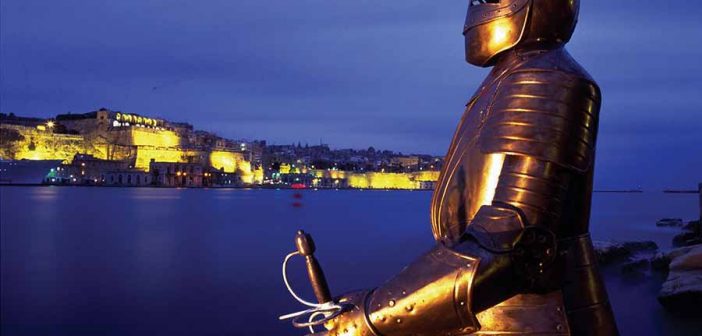Malta is small, unimaginably so for such a famous place. It is hard to come to terms with the size. You can fit two and half Maltas into Ireland’s smallest county, Louth.
The idyllic sister island Gozo is smaller again, one fifth the size of its neighbour where the airport and the entry point is to be found.
It really feels bigger. Which makes you wonder how you can fit so much activity, so much history and so much fame into one small place, 400,000 residents and 1.2m tourists, into such a space, and still have lots left over for the beaches, the terraces and the trademark stone fields and clay fields.
Fields laying out the loose boundaries between the suburbs of what is one big city state. Malta’s personality is defined by two words, old and stone. The dates are unimaginable, the temples that go back to an unimaginable time between the eras of Newgrange and Stonehenge. Phoenicians, Arabs, Carthaginians, Romans, and Normans stopped by. Each has left its trademark, most notably the language, a living breathing tongue with its Arab words, the only Semitic language to use the Roman alphabet.
At mass you can hear prayers to Gesu Kristu (Italian) and Alla (Arabic) in the same sentence in any one of the island’s 420 working churches all in the Baroque style, each more lavishly decorated than the last, and 63 in Gozo, with another on the island of Comino, whose three winter residents are joined by a hotel-full of tourists in summer.
It is one of the most reliable winter sun destinations in Europe, with lots of beach resorts.
The traditional, Catholic identity and the language have helped maintain its identity as empires fought over it, ensuring Malta made more noise than its size would suggest. A bus stop in the Mediterranean, Carina Dimech from the Maltese Tourist Association calls it. Some buses were less friendly than others. The Great Siege of 1565, in which Suleiman’s expansion plans were halted, was one of the most famous in history. The old and infirm were shipped away, the garrison withdrew to the citadels and the wells were poisoned and after a summer, the Turks were sent packing.
The French were welcomed in 1798 but the relationship turned sour after two months when they tried to seize the silverware from a Carmelite monastery in Mdina. The British arrived to another welcome, promising to hand the island back to its owners, the Knights of St John. Not untypically they broke the promise and stayed there until 1964. hanging on to a military base until 1979, airport, harbour – notably Fort St Angelo and some other tracts of valuable real estate.
For two years and four months the island suffered savage bombardment during World War II but remained an Allied stronghold on Axis shipping routes. Afterwards Malta was famously awarded a collective George Cross.
Today its accolades are cultural. Malta can boast five World Heritage sites, consisting of the entire capital city, Valletta, and four Neolithic temples.
There is a courtly air about the place, due to its elevated position as headquarters of the Knights of St John. For most of that time, the Knights brought wealth to the island, until the French revolution slashed their income to one sixth of its former level.
The folklore from that time remains mixed. The knights weren’t too happy with poverty. Vince Debono, one of the best of the tour guides on the island, says they were not extremely good at the chastity either.
The shared Catholicism, and the provincialate of orders such as the Salesians, means a strong Irish influence everywhere. The Hibernian soccer club (even the name) still ply their wares in the local league, and Floriana play in the Celtic colours. The tourism school does exchanges with Ireland and on the outskirts of Valetta, recently the five star Meridien hotel was sold to Irish tourism entrepreneurs.
This year it joins the euro making it an even more attractive destination. And direct Ryanair flights from Dublin mean that holiday makers can plan short breaks through the reliable winter weather, to sample the cuisine (the magnificent fish, the lampuka ended up on the Maltese 10c piece) and huge variety of local wines – not to mention a stop to see the old stone fortifications, churches and catacombs that have been left by Malta’s amazingly diverse history, the legacy of 7,000 years all conveniently clustered in a handful of locations, Valletta, the old capital of Mdina and the Neolithic temples to be found on the south of Malta.
Best place to start is the Malta Experience Show using state-of-the-art multi-vision technology to tell the amazing story in a 45 minute burst.
Mdina, the Silent City was Malta’s first capital city during the time of the Knights of Malta, and a colonial settlement of Imperial Rome, has a collection of Roman mosaic pavements that are among the oldest and finest in the Med.
St Paul’s Catacombs and St Paul’s grotto offer a glimpse back to the earliest days of Christianity. When the order came to destroy the catacomb tables, Malta ignored it, making these the best preserved catacombs of all.
In Valetta, the lavishly adorned baroque St. John’s Co-Cathedral houses beautiful works by Mattia Preti and two paintings by Caravaggio, St Jerome and the magnificent Beheading of the Baptist in the Oratory, reputed by art historians to be the finest painted executed by anyone in the 1600s.
Apply in the local bars for details of Caravaggio’s stay in Malta – he arrived as a refugee and left as a fugitive.
And the bars are lively. It can be hectic, it can be noisy, and in summer there is a festa every weekend, noisy three-day affairs consisting of fireworks, brass bands, and inebriation. Thank back to the match that qualified Ireland for Italia 90 and you have the idea.
But there is always an escape to the idyllic rural haunts of Gozo, or somewhere nearer.
Mdina by night: The people are gone. Silence reigns. The lights are magical. You leave Malta enchanted by the nights as well as the knights.
Malta Experience Show: the island’s premier audio visual spectacular telescoping 7000 years of turbulent change and drama into an unforgettable 45 minutes.
Roman Domus: the ‘Roman house’ at Rabat offers the finest and oldest mosaic compositions from the western Mediterranean. They were discovered in 1881 just outside Mdina in the remains of a rich and sumptuously decorated town house of the Roman period.
St. Paul’s Catacombs: Roman graves and passages called after St Paul because of their vicinity to St Paul’s church and grotto.
Mdina Malta’s first capital city: the medieval townhouses, the oldest of which dates to 1233, are called Siculo-Norman after their jumble of architectural styles – Arabic, Sicilian and Norman.
Mdina old town boasts handsome fortifications pierced by baroque gates as well as convents, churches, and the island’s massive cathedral built in 1693. Check the cuisine at Cosmana Navarra Restaurant.
St. John’s Co-Cathedral Baroque masterpiece constructed 1573-77 during the reign of Gran Master Jean de la Cassiere, works of art include those by Mattia Preti and Caravaggio.
- Malta is on offer from 12 major tour operators. Ryanair fly six times a week to Malta www.ryanair.com
- Eoghan Corry stayed at the five star Corinthia Palace Hotel, Attard +356 2543001. The Athenaeum spa by Algotherm has one of the best menus you will find anywhere, with everything from botox to micro exfoliation therapy www.athenaeumspa.com.mt
- Excelsior Grand Hotel Malta opens in the new year with 400 rooms and conference facilities offering stunning views overlooking Valetta harbour +356 2125 0520 www.excelsior.com.mt
- Tourguide was Vince deBono info@guideinmalta.com




